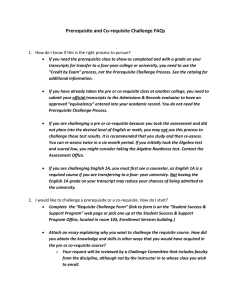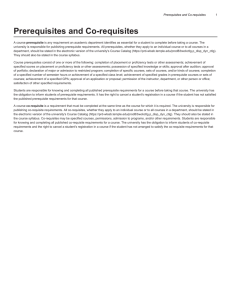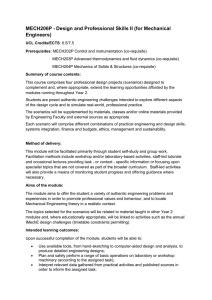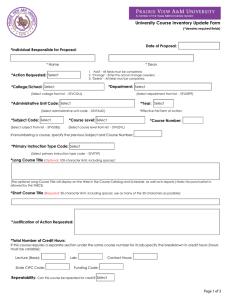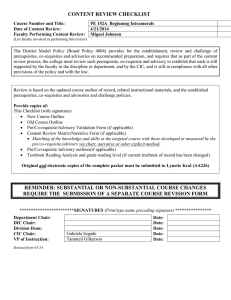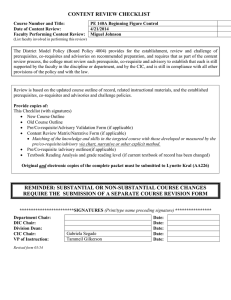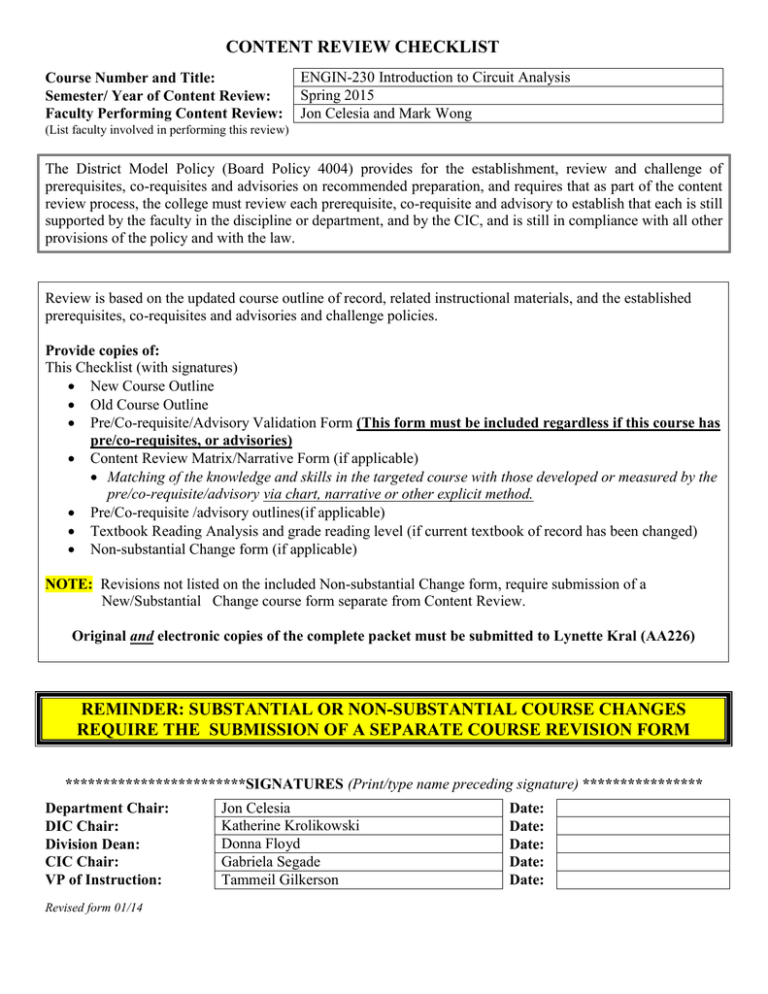
CONTENT REVIEW CHECKLIST
Course Number and Title:
Semester/ Year of Content Review:
Faculty Performing Content Review:
ENGIN-230 Introduction to Circuit Analysis
Spring 2015
Jon Celesia and Mark Wong
(List faculty involved in performing this review)
The District Model Policy (Board Policy 4004) provides for the establishment, review and challenge of
prerequisites, co-requisites and advisories on recommended preparation, and requires that as part of the content
review process, the college must review each prerequisite, co-requisite and advisory to establish that each is still
supported by the faculty in the discipline or department, and by the CIC, and is still in compliance with all other
provisions of the policy and with the law.
Review is based on the updated course outline of record, related instructional materials, and the established
prerequisites, co-requisites and advisories and challenge policies.
Provide copies of:
This Checklist (with signatures)
New Course Outline
Old Course Outline
Pre/Co-requisite/Advisory Validation Form (This form must be included regardless if this course has
pre/co-requisites, or advisories)
Content Review Matrix/Narrative Form (if applicable)
Matching of the knowledge and skills in the targeted course with those developed or measured by the
pre/co-requisite/advisory via chart, narrative or other explicit method.
Pre/Co-requisite /advisory outlines(if applicable)
Textbook Reading Analysis and grade reading level (if current textbook of record has been changed)
Non-substantial Change form (if applicable)
NOTE: Revisions not listed on the included Non-substantial Change form, require submission of a
New/Substantial Change course form separate from Content Review.
Original and electronic copies of the complete packet must be submitted to Lynette Kral (AA226)
REMINDER: SUBSTANTIAL OR NON-SUBSTANTIAL COURSE CHANGES
REQUIRE THE SUBMISSION OF A SEPARATE COURSE REVISION FORM
************************SIGNATURES (Print/type name preceding signature) ****************
Department Chair:
DIC Chair:
Division Dean:
CIC Chair:
VP of Instruction:
Revised form 01/14
Jon Celesia
Katherine Krolikowski
Donna Floyd
Gabriela Segade
Tammeil Gilkerson
Date:
Date:
Date:
Date:
Date:
NON-SUBSTANTIAL COURSE/CATALOG CHANGE DURING CONTENT REVIEW
Please mark an "X" in the box of the item that has been revised.
Course Title
Course Description
Hours per term
Grade Option
Pre/Co-requisite/Advisory
X
Course Objectives/Course Content
Methods of Instruction
Outside Class Weekly Assignments
Instructional Materials
Student Evaluation
Reason for Change
CURRENT COURSE INFORMATION (Fill in the current department/course number/title and only areas that are being revised)
Course Number/Title:
Hours per semester:
Lecture:
Grade Option:
Letter
Lab:
HBA (Lecture):
Student Choice
HBA (Lab):
Pass/No Pass
Pre-requisite(s):
Co-requisite(s):
Advisory(ies):
CHANGE TO: Check box and fill in those parts that are being revised.
Course Title (limited to 39 character spaces):
Course Catalog Description: (Type new course description in expanding box below)
Hours per term:
Lecture:
Lab:
Grade Option:
Letter Grade
Student Choice
Prerequisite:
Delete:
Add:
Prerequisite:
Delete:
Add:
Co-requisite:
Delete:
Add:
Co-requisite:
Delete:
Add:
Advisory:
Delete:
Add:
HBA (Lecture):
Pass/No Pass
HBA (Lab):
This form must be included regardless if this course has pre/co-requisites, or advisories
CONTRA COSTA COLLEGE
PRE/CO-REQUISITE/ADVISORY VALIDATION FORM
[Use one validation form per pre/co-requisite, advisory except when Pre/Co-requisites are linked by “or” statements]
Course Number and Title:
ENGIN-230 Introduction to Circuit Analysis
Pre/Co-requisite/Advisory to be validated:
X Yes
No
MATH-290 and PHYS-230
The department has reviewed each prerequisite, co-requisite, or advisory to
establish that each is still supported by the faculty in the discipline or department, or that the
student would not benefit from an additional prerequisite, co-requisite, or advisory to this
course. .
Content review is required for any prerequisite, co-requisite, or advisory to determine whether students
who do not meet the specified standard are highly unlikely to receive a satisfactory grade in the course
[Title 5, Section 55201 (b) (1]. This validation is separate from course approval. Additional scrutiny may be
required, depending on the type of pre/co-requisite.
Directions: Circle, or highlight one of the following and attach required justification AND content review
documentation.
1.
This course has no course pre/co-requisites or advisories.
2.
The course is an advisory only.
3.
This is a lab course. The primary course, ___________________, will have the validation evidence.
4.
This pre/co-requisite is required in order to make the course acceptable for transfer by the UC or CSU
systems. Attach documentation (catalog descriptions) from three or more UC/CSU campuses.
5.
This course is part of a sequence of courses within and/or across disciplines. Attach a copy of the course
outline that includes a list of the specific skills and knowledge that the student must possess to be ready
to take the course.
6.
The prerequisite is required for enrollment in a program.
Program name: ________________________ Program prerequisite(s) must be approved as provided for
at least one required course in the program, of which this is one. Attach copy of course outline
specifying skills and/or knowledge that student must possess.
7.
This prerequisite is required for the health or safety of the students in the course; students who lack this
prerequisite might endanger themselves or other students. Attach a copy of the course outline that
specifically lists what the student must possess before entering the course.
8.
This pre/co-requisite is required by law or government regulation. Attach a copy of pertinent law or
regulation.
9.
This pre/co-requisite is one of recency or another measure of readiness. Attach both a copy of the course
outline listing the specific skills student must possess AND data gathered as directed by the District
Model Policy.
10.
This prerequisite involves a limitation on enrollment. This includes auditions for performance courses,
honors courses or sections, and blocks of courses or sections created to set up a cohort of students (such
as PACE). Attach documentation as directed by pertinent sections of the District Model Policy.
***
NOTE: In addition to rigorous content review, an instructor may request a study of the empirical relationship between a
prerequisite course (or placement tool) and subsequent student performance in the targeted course. The rigor of content
review will be established on a college-wide basis in conjunction with District research requirements.
Revised form 01/14
CONTENT REVIEW MATRIX
FOR EVALUATING PRE/CO-REQUISITES/ADVISORIES
Pre/Co-requisites must have established challenge policies
Course Number:
Course Title:
Pre-requisite:
Co-requisite:
Advisory:
ENGIN-230
Introduction to Circuit Analysis
MATH-290
Pre/Co-requisite Challenge Policy:
Departmental Exam or Proof of Completion of Equivalent Course
List entrance skills/body of knowledge: (APPLICABLE Course CONTENT of course being reviewed)
1.
Evaluate integrals
2.
Perform operations on functions of several variables
3.
4.
5.
6.
7.
8.
List exit skills of proposed pre/co-requisite: (APPLICABLE Course OBJECTIVES of pre/co-req./advisory)
1.
perform operations on vectors, including:
(a)
sketch vectors in the plane and in space
(b)
find the dot product and cross product of two vectors
(c)
apply vector products to calculate work and torque
2.
sketch lines, surfaces, and curves in space
3.
perform operations on vector-valued functions, including:
(a)
differentiation and integration
(b)
determine velocity and acceleration
(c)
compute tangent and normal vectors, arc length, and curvature
4.
5.
6.
7.
8.
9.
perform operations on functions of several variables, including:
(a)
evaluate limits and determine continuity
(b)
compute partial derivatives and differentials
(c)
find directional derivatives and the gradient
(d)
obtain equations of tangent planes and normal lines to a surface in space
(e)
find extrema of functions of two variables
evaluate multiple integrals to find:
(a)
area and volume
(b)
center of mass and moments of inertia
(c)
surface area
use vector fields to:
(a)
evaluate line integrals
(b)
determine path independence
(c)
apply Green's theorem to regions in the plane
(d)
apply Stokes' theorem and the divergence theorem to regions in space.
Entrance skills/body of
knowledge
1.
1.
2.
3.
4.
5.
6.
7.
8.
9.
10.
Exit skills of proposed pre/co-req./advisory
2. 3. 4.
5.
6. 7.
8. 9.
X
X
10.
Or, list conclusions below regarding the necessity and appropriateness of the proposed pre-requisite, co-requisite, or advisory.
Revised form 01/14
CONTENT REVIEW MATRIX
FOR EVALUATING PRE/CO-REQUISITES/ADVISORIES
Pre/Co-requisites must have established challenge policies
Course Number:
Course Title:
Pre-requisite:
Co-requisite:
Advisory:
ENGIN-230
Introduction to Circuit Analysis
PHYS-230 (may be taken concurrently)
Pre/Co-requisite Challenge Policy:
Departmental Exam or Proof of Completion of Equivalent Course
List entrance skills/body of knowledge: (APPLICABLE Course CONTENT of course being reviewed)
1.
Knowledge of electric potential
2.
Basic knowledge of circuits
3.
Knowledge of magnetism
4.
5.
6.
7.
8.
9.
List exit skills of proposed pre/co-requisite: (APPLICABLE Course OBJECTIVES of pre/co-req./advisory)
Apply Coulomb’s Law to electrostatic charge distributions
1.
2.
Evaluate the electric field due to a variety of static charge distributions
Evaluate the electric potential due to a variety of static charge distributions
3.
Solve circuits containing capacitors with dielectrics
4.
Analyze and solve DC circuits
5.
Demonstrate an understanding of the origin of magnetic fields
Apply the Biot-Savart Law to evaluate the magnetic field due to a current element
Solve circuits containing inductors
Differentiate between materials that are ferromagnetic, paramagnetic, or diamagnetic
Solve AC circuits
Apply Maxwell’s equations to explain the production of electromagnetic waves
Entrance skills/body of
knowledge
1.
1.
2.
3.
4.
5.
6.
7.
8.
9.
10.
Exit skills of proposed pre/co-req./advisory
2. 3. 4.
5.
6. 7.
8. 9.
X
X
X
X
X
X
X
X
10.
X
X
Or, list conclusions below regarding the necessity and appropriateness of the proposed pre-requisite, co-requisite, or advisory.
Revised form 01/14
Contra Costa College
Course Outline
Course Number
Course Title
Prerequisite
Challenge Policy
ENGIN-230
Introduction to Circuit Analysis
MATH-290 and PHYS-230
Departmental Exam or Proof of Completion of
Equivalent Course
Co-requisite
Challenge Policy
Advisory
*HOURS BY ARRANGEMENT:
Number of Weeks
Lecture Hours By Term
Lab Hours By Term
*Hours By Arrangement
Units
18
54
54
4
Hours per term.
ACTIVITIES: (Please provide a list of the activities students will perform in order to satisfy the HBA requirement):
COURSE/CATALOG DESCRIPTION
This course provides primary emphasis on developing models and techniques for analyzing the natural and
forced response of passive linear networks. Models and circuit applications for diodes, transistors, and
operational amplifiers are introduced. Laboratory experiments with each of the fundamental circuit types
and related test equipment are conducted.
COURSE OBJECTIVES:
At the completion of the course the student will be able to:
Demonstrate a thorough understanding of basic electric-circuit components, models, and techniques.
Demonstrate good problem-solving techniques.
Analyze the natural and forced responses of DC, 1st-order, and 2nd-order passive linear circuits.
Relate real to ideal circuit elements and learn the proper use of standard electronics test equipment.
INTENDED STUDENT LEARNING OUTCOMES:
Use Function Generator, Digital Multimeter and Analog or Digital Oscilloscope to correctly determine the type and value of
passive, linear components in three, two-element, circuits in a “black box”.
Correctly analyze the current and voltage transient and steady-state response of a passive, linear RLC circuit to
step or sinusoidal voltage or current forcing functions.
COURSE CONTENT (Lecture):
1.
Principles and Techniques of DC Circuit Analysis
a.
DC Circuit variables and elements
b.
Kirchoff's Laws
c.
Mesh and nodal analysis
d.
Power and energy
2.
3.
4.
e.
Superposition, Thevenin's and Norton's theorems
f.
DC circuit construction instrumentation
g.
Operational Amplifiers
Response of Circuits with Inductors and Capacitors
a.
Basic operating principles of inductors and capacitors
b.
Natural response and complete response of first-order circuits
c.
Natural response and complete response of second-order circuits
d.
Sinusoidal steady-state analysis
e.
Complex frequency response
f.
Introduction to LaPlace Transforms
Semiconductor Principles
a.
The semiconductor diode
b.
Operation of bipolar and field-effect transistors
c.
Introduction to digital logic
Circuit Analysis with Computer-simulations
a.
Introduction to PSPICE
b.
Application of PSPICE to DC circuits
c.
Application of PSPICE to find the transient and steady-state
response of RLC circuits
COURSE CONTENT (Lab):
PSpice and passive sign convention
I-V Curves (sources and sinks)
Voltmeters
Operational amplifiers
Thevenin’s and Norton’s equivalent circuits
Transient and DC-steady state response in 1st order circuits
Natural and steady-state response in RLC parallel circuits
Natural and steady-state response in RLC series circuits
Analysis of steady-state sinusoidal voltages (phasors)
RLC identification (“black box”)
Power factor correction and maximum power theorem
Analog to digital converter (ADC)
METHODS OF INSTRUCTION:
Classroom presentation is largely lecture/demonstration with many opportunities allowed for questions of
and by the students. Many of the basic concepts and their applications are illustrated with laboratory
experiments, computer simulations and exercises.
INSTRUCTIONAL MATERIALS:
NOTE: To be UC/CSU transferable, the text must be dated within the last 7 years OR a statement of justification for a text beyond the
last 7 years must be included.
Textbook Title:
Author:
Publisher:
Edition/Date:
Justification Statement:
Textbook Reading Level:
Lab Manual Title
Author:
Publisher:
Edition/Date:
Electric Circuits
Nilsson and Riedel
Pearson Prentice Hall
9th Edition/ Copyright 2010
(For textbook beyond 7 years)
Contra Costa College Engineering 230 Lab Manual
Contra Costa College Astronomy/Physics/Engineering/Geology Department
CCC Bookstore
Spring 2015
OUTSIDE OF CLASS WEEKLY ASSIGNMENTS:
Title 5, section 55002.5 establishes that a range of 48 -54hours of lecture, study, or lab work is required for one unit of credit.
For each hour of lecture, students should be required to spend an additional two hours of study outside of class to earn one
unit of credit.
Title 5, section 55002(a) 2F establishes that coursework calls for critical thinking and the understanding and application of concepts
determined by the curriculum committee to be at college level.
For degree applicable courses: List one example of critical thinking homework
Outside of Class Weekly Assignments
Hours per week
Weekly Reading Assignments (Include detailed assignment below, if applicable)
3
Read Chapter 7, pages 277 - 321
Weekly Writing Assignments (Include detailed assignment below, if applicable)
Weekly Math Problems (Include detailed assignment below, if applicable)
3
Chapter 7: Problems 1, 3, 8, 10, 23, 26, 28, 33, 39,43
Critical thinking homework example:
How much power is dissipated in a 10 ohm resistor connected to a 10 volt source?
Lab or Software Application Assignments (Include detailed assignment below, if applicable)
Other Performance Assignments (Include detailed assignment below, if applicable)
STUDENT EVALUATION: (Show percentage breakdown for evaluation instruments)
Title 5, section 55002 (a) 2A establishes that the grade is based on demonstrated proficiency in subject matter and the ability to
demonstrate that proficiency.
For degree applicable courses: Course requires essay writing, or, in courses where the curriculum committee deems them
to be appropriate, by problem solving exercises, or skills demonstrations by students.
%
Essay
70
15
15
%
Computation or Non-computational Problem Solving Skills
%
Skills Demonstration
%
Objective Examinations
%
%
%
Other (describe)
Lab assignments
Homework
GRADING POLICY: (Choose LG, P/NP, or SC)
Pass / No Pass
X Letter Grade
90% - 100% = A
80% - 89% = B
70% - 79% = C
60% - 69% = D
Below 60% = F
70% and above = Pass
Below 70% = No Pass
Student Choice
90% - 100% = A
80% - 89% = B
70% - 79% = C
60% - 69% = D
Below 60% = F
Percentages vary from instructor
to instructor
or
70% and above = Pass
Below 70% = No Pass
Prepared by: Jon Celesia and Mark Wong
Date: Spring 2015
Revised form 09/14

